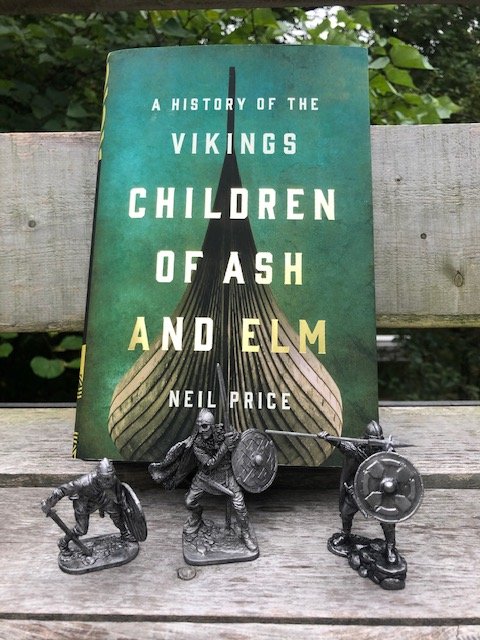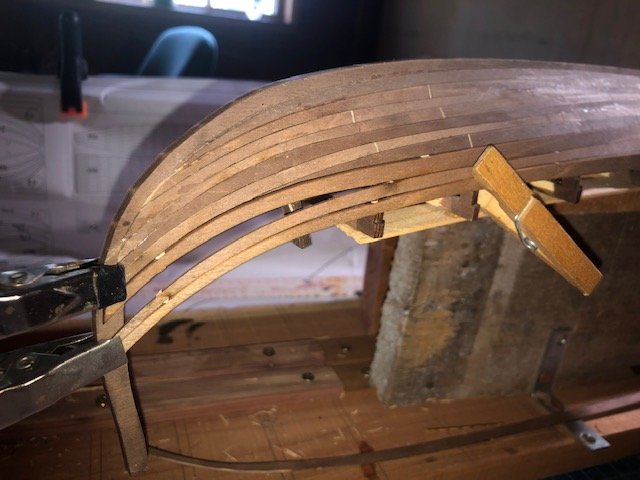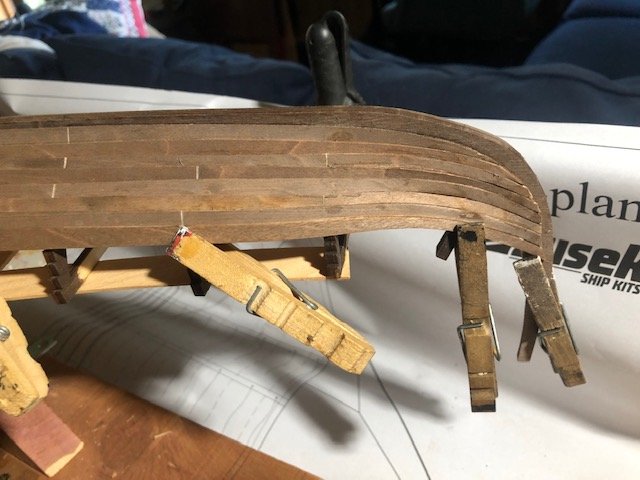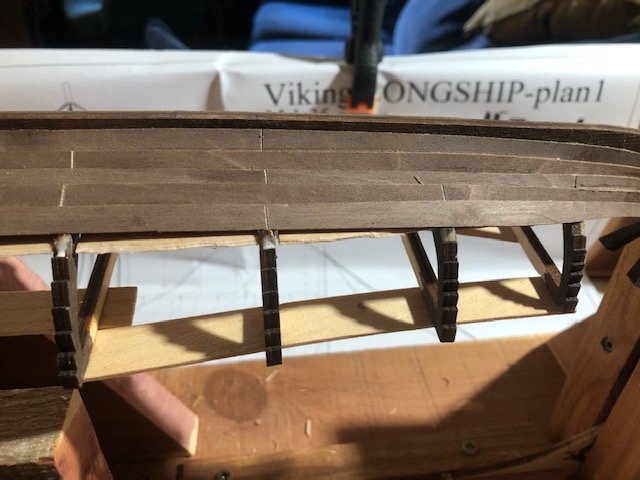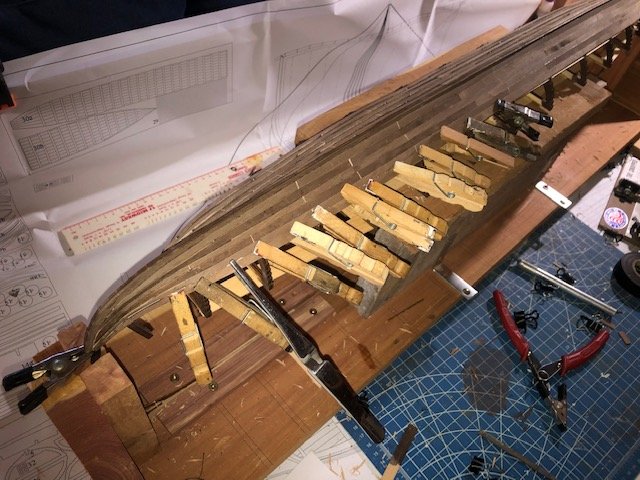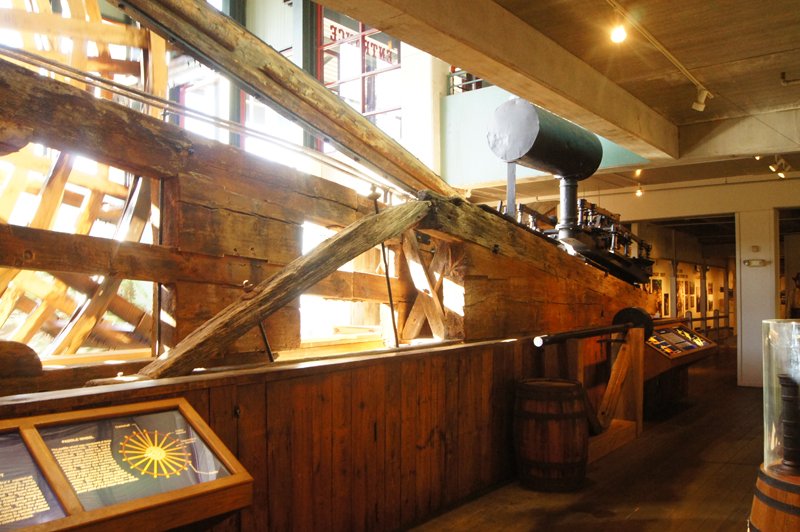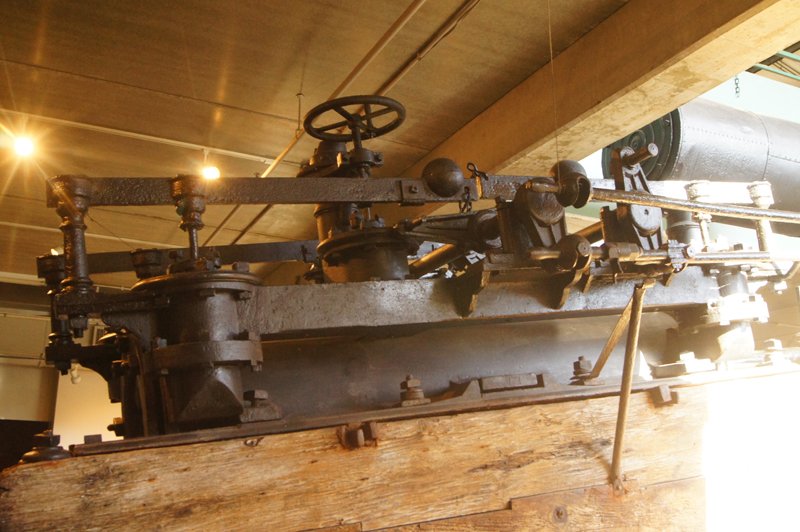-
Posts
3,502 -
Joined
-
Last visited
Content Type
Profiles
Forums
Gallery
Events
Everything posted by Cathead
-

Chaperon by joep4567 - 1:48 - Sternwheeler
Cathead replied to joep4567's topic in - Build logs for subjects built 1801 - 1850
Looks about right. One way to judge scale would be to create a rough human figure and see whether the arms are roughly at the right level for human use. Mine's too deep in the model to measure it, but I think it was 3-4' tall. As far as I know, these connected directly to the river and were used for two main purposes: to prime the doctor pump when steam wasn't available, and for light general hosing or any other use for riverwater. Note that the original has a line leading to the doctor and a connection on the front to attach a hose or pipe. I'm actually not sure how they dealt with water in the hold, as steamboats' flat bottom meant that there was no central bilge for water to collect in that could be reliably accessed by a pump. Maybe they ran a leather hose down there from one of the main pumps? -
Yeah, I looked at a lot of options closely and this series struck me as quite good. I'm not an expert but saw no obvious flaws. These are from my mother; I gave her five options and told her to pick a few from those; my initial five were the most accurate and most appealing to me (for example, I left out archers as they were fairly uncommon). I also like that there's a range from the jarl in the middle (lots of mail, fancy shield, decorated scabbard) to the basic warrior on the left (leather jerkin, plain wood shield, etc.). Will show more details as I work on them. She must like swords as she left out both axe warriors. If I enjoy painting these I may have to add a few of those, as axes from this area are more unique than the swords at this scale (not sure I can fit "Ulfberht" on there). I don't have an airbrush. Any advice on brush-painting (other than get one)? As for the title, I wondered that too, but will fill you in when it gets there. Also, thanks again for all the above advice. I've started experimenting and will let you know what ends up working best. I've already figured out one lead that is promising.
-
I don't think it's a faulty part as it would have to be a flaw in the entire laser-cut sheet; also, as there are two of each part and each plank matches its counterpart, again it's not likely a manufacturing flaw. It's either a design flaw of some kind or some mistake on my part. Possibly a bit of both, if I somehow haven't been laying the planks out juuuust right then maybe the curves could be going off. But that's where the kit needs better directions if it's going to be that sensitive to minor user error. In any case, I'm going to try various fixes and see what I like best. In the meantime, today was my 41st birthday and some fun inspiration arrived: This is a recent book that comes highly reviewed. It seems to take a very comprehensive view, incorporating broader geographic elements, which is especially appealing to two geologists. The figurines are 1:32, close enough to the kit's 1:35 and a fun painting project (I've never painted figures at this scale before). So despite my frustrations, I now have powerul motivation to keep going.
-
This kit just keeps getting weirder. I've done strakes 17-23 now (numbering upward from the keel, using the kit's part numbers). They've been fitting less and less well as I go up (especially at the stern) and I've had to do more and more bending and filing to keep things in place. The pre-spiled planks just don't want to follow the curves of their neighbors. Then, when I got to #24, the wheels just came off entirely. Here are strakes 24, 25, and 26 temporarily clamped in place (26 is the "uppermost" but lowest in the photo). Note that 24 doesn't even come close to the curve of 23, in fact it blends smoothly over it and fully overlaps it by the time you reach the stem. Then 25 and 26 follow a wildly different curve, matching each other but not the rest. They're sort of parallel to 23, but with a huge gap (24 would have to be at least twice as wide as the rest to fill that hole even if followed the curve of 23). All of these are in their "right" place as determined by the pre-cut notches in the frame (under the clothespin on the right). I tried shifting 25 and 26 down a place (butting against 23) but they don't fit like that either. I'm sure I'm using the "right" plank, having triple-checked the plans and even tried several other plank shapes in case the sheets are numbered wrong. Nothing fits, and once you start rearranging all the other planks everything just goes haywire. I have no idea what's going on or what to do. I've already tried soaking and bending 24 into some kind of conformation but it really doesn't want to match that shape, and when you do that 25 and 26 don't line up at all, so it doesn't really get you anywhere. I supposed I could try to trace out a pattern of what plank shape would fit this gap and try to cut it out of the edge of the leftover planking sheets? It'll look terrible, being at least twice as wide as all the others, but what else can I do? Also, returning to the question of whether I'm somehow using the "wrong" plank, the other end of 24 fits reasonably well (as have all the bow strakes): Ideas? I'm open to the idea that this is all somehow user error, but I'm a reasonably experienced modeller who has planked a number of hulls reasonably successfully and never had anywhere near this much trouble. And even if it is user error, I'm in too deep now and have to dig myself out. I'm really starting to dislike this kit. If I can just get the hull planked at a non-embarassing level, I think I can make the rest of it look pretty good, but man is it fighting back.
-
Maybe it hasn't fallen into the swamp, but it does have huuuuge....castles. Nice job on the fix.
- 179 replies
-
- shipyard
- wütender hund
-
(and 1 more)
Tagged with:
-
Thanks for the support. I have some fun ideas for finishing/customizing this later on, just have to get through the slog of basic planking and problem-solving. I still think it's going to turn out pretty cool.
-

Chaperon by joep4567 - 1:48 - Sternwheeler
Cathead replied to joep4567's topic in - Build logs for subjects built 1801 - 1850
I just compared my original photos with those I included in the link above, and there aren't any others that are remarkably different. Your rudder posts look nice. -
Slow progress on planking and haven't taken many photos. I am now reaching the level of the false deck, where another of this kit's quirks comes into play along with the very poor directions. If you're familiar with Viking ship construction, you may have been confused by the design of this model so far. It has frames extending from the keel to the uppermost strake, just like a normal ship hull. However, real Viking ships did not have framing like that; they were built shell-first and then small frames were fit inside the shell afterward. There was no one frame that extended all the way, and indeed the strakes above the deck were supported only by small braces. In other words, this is nothing like a typical longboat built on a skeleton. Yet the model has full framing, one assumes to give sufficient guidance for laying out the overlapping clinker planking as this would otherwise be rather difficult to do right. The instructions simply tell you to glue all the planks on until the hull is complete. Yet this would leave you with a wildly inaccurate hull interior full of thick ribs! So there is a vague followup-instruction that tells you to "cut off the parts of the ribs...which overlap the deck". After a private consultation with Binho (who has passed this stage on the smaller version of this kit; thank you!), I finally understood that you're supposed to finish the hull and then cut all the frames out that extend above the deck. Of course, this would be much harder to do if you glued all the planking to the frames, especially in clinker hull where you can't just slide a blade along the smooth curve between the planking and frame of a carvel hull! So essentially what you need to do, once the planking goes above the deck, is stop gluing the planks to the frames and only glue them to each other. This will make it a whole lot easier to cut out the extraneous framing afterward (as you just have to make once cut through the frame at deck level), but the instructions never mention this (indeed, there's a vague image of a knife carving the planking from the frame, which just sounds problematic in all sorts of ways). Given the curve of the planking, I'm at the point where the planks start to rise from below deck level to above deck leve at bow and stern. So in the image below, there is glue on the two left-hand frames and none on the two right-hand frames for this reason (glue on the overlap has not been applied yet). From here on up, I will not be gluing anything to the frames because they will need to be removed. This also makes it clear that I shouldn't have bothered staining the frames because they either get cut away or hidden beneath the deck. Didn't quite grasp that when I was starting. I'm also finding that, in some areas, the planks have almost no overlap even when they sit exactly as they're meant to in the pre-carved frames. This makes it really hard to get a good glue bond between strakes, which becomes ever more important once the frames aren't holding the planks in place any more. It's possible this relates to me not quite getting the planks aligned just as intended in the kit design, but it really does feel like these planks just aren't cut out quite right (as mentioned above with the obvious problems in length and layout). Just not that impressed; if all of this is due to my errors (which is possible), it still leads back to very poor instructions that made it impossible to understand how to lay these out precisely right in the first place. Earlier I mentioned that I might have trouble holding the planks in place once the deck started interfering with my normal clamps. This has turned out to be a non-issue, because this close to the deck things like clothespins and other clamps work great, and in fact make it easier to hold the planks together because you can now clamp all the way along the joint, like this: This couldn't be done earlier because the deck was in the way. I assume this is how planking will look from now on as the strakes keep rising above the deck. I'm also going to have to be more careful about glue drips in the interior, which up until now I didn't worry about because it would be hidden, but not anymore. I may abandon my building frame and just start working freehand, as the hull is now pretty stiff and I'll need to be turning the model back and forth to check on both exterior and interior alignment and appearance. So that's that. Planking can be pretty dull work and I've been moving slowly as life keeps throwing other things at me. Thanks for sticking with me and reading (or at least skimming) my blathering on. Although I work as an editor, I don't always reread my own writing here because it feels too much like work, so I probably take more verbiage than I really need to explain stuff.
-

Chaperon by joep4567 - 1:48 - Sternwheeler
Cathead replied to joep4567's topic in - Build logs for subjects built 1801 - 1850
Please do, we're all here to take ideas and inspiration from each other. I have several photos of the Arabia's original pumps if you want to work from them instead of the model version. There are a few in my planning thread, but I think I have other angles as well if you want them. Let me know if you want them posted here or shared with you privately to avoid clogging up the thread. I actually don't know what kinds of pumps Chaperon had or how they were arranged, given that she was built decades after Arabia and a lot had changed by then, but pumps are a fun detail. You could always ask someone like Kurt Van Dahm if you care. -
Can you explain what you mean here in more detail? I'd like to understand what you're doing but don't understand "erose".
-
Congratulations! It's been great to follow along on this and maintain inspiration for my own build.
-

Chaperon by joep4567 - 1:48 - Sternwheeler
Cathead replied to joep4567's topic in - Build logs for subjects built 1801 - 1850
If you're going to have a view into the engine room, a few more nice details would include a sturdy workbench and an anvil/forge, since these boats often had to be responsible for their own repairs (including metal work). Still looking great. -

2021 NRG CONFERENCE
Cathead replied to kurtvd19's topic in NAUTICAL RESEARCH GUILD - News & Information
Haven't been there, but definitely fits within the broader scope of attendee interests. -

2021 NRG CONFERENCE
Cathead replied to kurtvd19's topic in NAUTICAL RESEARCH GUILD - News & Information
As long as I'm tilting at this windmill, I'll add in the amazing National WWI Museum, also in central Kansas City, which is a must for anyone even remotely interested in history. Can't believe I forgot it in my initial post. -

2021 NRG CONFERENCE
Cathead replied to kurtvd19's topic in NAUTICAL RESEARCH GUILD - News & Information
On the California accessibility issue, I'd just like to point out that California has excellent train service from LA up the coast. Many trains a day with stops in small towns all along the way, essentially European-style commuter rail. The last time we visited the Channel Islands, that's what we did, arrived in LA but didn't rent a car until we got off the train in Ventura. It's not difficult and traffic becomes a non-issue; just expand your mind from assuming cars are the only way to get around. We were planning to do the same thing this year before 2020 did its best Vasa impression and tentatively hope to do so in 2021. As as plains/midwestern resident, I'd like to suggest that the saltwater folks expand their horizons and be open to learning something new once a decade. A dark horse candidate would be Kansas City, much easier to get to than Toledo or Duluth (bigger airport), which has a world-class steamboat museum downtown (and another one a few hours upriver near Omaha, perfect for a day trip) and a lot of affordable convention/lodging options. There are plenty of us in the midwest and a lot of good models would show up at such a central location that's within a long day's drive of everything from Denver to MSP to Chicago to Memphis to Dallas. A special conference theme could be freshwater maritime history, not just of the interior US but all over the world. There's also a lot of access to less-well-known Civil War and American frontier history (including Lewis & Clark) that would complement the broader historical interests most of us have. -
Looks so good. One detail I love in original steamboat engine timbers is the scarph joints between the timbers (both between the horizontal timbers and between the slanted timber and the angled surface below it). It'd be really hard to do right in a model and would barely by seen, but it makes a lot of sense for strengthening the original assembly for the pounding it took from engine operation. You can see these in your photo above and on the Arabia's timbers as well:
-
Yeah, my goal is just to make it as representative as I can, and if I ever show it to a real expert (unlikely) I'll have The Conversation about how it Isn't Right.
About us
Modelshipworld - Advancing Ship Modeling through Research
SSL Secured
Your security is important for us so this Website is SSL-Secured
NRG Mailing Address
Nautical Research Guild
237 South Lincoln Street
Westmont IL, 60559-1917
Model Ship World ® and the MSW logo are Registered Trademarks, and belong to the Nautical Research Guild (United States Patent and Trademark Office: No. 6,929,264 & No. 6,929,274, registered Dec. 20, 2022)
Helpful Links
About the NRG
If you enjoy building ship models that are historically accurate as well as beautiful, then The Nautical Research Guild (NRG) is just right for you.
The Guild is a non-profit educational organization whose mission is to “Advance Ship Modeling Through Research”. We provide support to our members in their efforts to raise the quality of their model ships.
The Nautical Research Guild has published our world-renowned quarterly magazine, The Nautical Research Journal, since 1955. The pages of the Journal are full of articles by accomplished ship modelers who show you how they create those exquisite details on their models, and by maritime historians who show you the correct details to build. The Journal is available in both print and digital editions. Go to the NRG web site (www.thenrg.org) to download a complimentary digital copy of the Journal. The NRG also publishes plan sets, books and compilations of back issues of the Journal and the former Ships in Scale and Model Ship Builder magazines.



